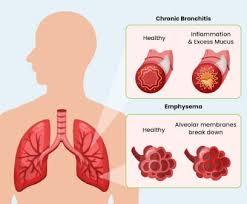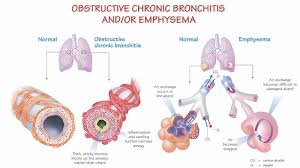
Several processes can cause the airways to become narrow and lead to COPD. There may be destruction of parts of the lung, mucus blocking the airways, and inflammation and swelling of the airway lining.
COPD develops gradually over time, often resulting from a combination of risk factors:
- tobacco exposure from active smoking or passive exposure to second-hand smoke;
- occupational exposure to dusts, fumes or chemicals;
- indoor air pollution: biomass fuel (wood, animal dung, crop residue) or coal is frequently used for cooking and heating in low- and middle-income countries with high levels of smoke exposure;
- early life events such as poor growth in utero, prematurity, and frequent or severe respiratory infections in childhood that prevent maximum lung growth;
- asthma in childhood; and
- a rare genetic condition called alpha-1 antitrypsin deficiency, which can cause COPD at a young age.
COPD should be suspected if a person has typical symptoms, and the diagnosis confirmed by a breathing test called spirometry, which measures how the lungs are working. In low- and middle-income countries, spirometry is often not available and so the diagnosis may be missed.
Treatment
COPD isn’t curable, but it can get better by not smoking, avoiding air pollution and getting vaccines. It can be treated with medicines, oxygen and pulmonary rehabilitation.
There are several treatments available for COPD.
Inhaled medicines that open and reduce swelling in the airways are the main treatments.
Bronchodilator inhalers are the most important medicines for treating COPD. They relax the airways to keep them open.
Short-acting bronchodilators start to work in seconds and can last for 4–6 hours. These are often used during flare-ups.
Long-acting bronchodilators take longer to start working but last longer. These are taken daily and can be combined with inhaled steroids.
Other treatments may also be used:

- Steroid pills and antibiotics are often used to treat flare-ups.
- Oxygen is used for people who have had COPD for a long time or have severe COPD.
- Pulmonary rehabilitation teaches exercises to improve your breathing and ability to exercise.
- Surgery may improve symptoms for some people with severe COPD.
Some inhalers open the airways and may be given regularly to prevent or reduce symptoms, and to relieve symptoms during acute flare-ups. Inhaled corticosteroids are sometimes given in combination with these to reduce inflammation in the lungs.
Inhalers must be taken using the correct technique, and in some cases with a spacer device to help deliver the medication into the airways more effectively. Access to inhalers is limited in many low- and middle-income countries; in 2021 salbutamol inhalers were generally available in public primary health care facilities in half of low- and low-middle income countries.
Flare-ups are often caused by a respiratory infection, and people may be given an antibiotic or steroid tablets in addition to inhaled or nebulised treatment as needed.
Leave a Reply